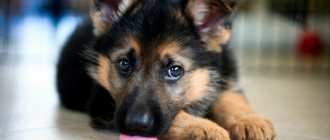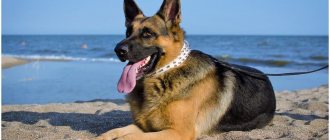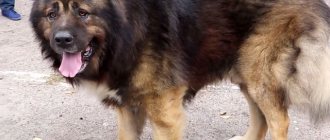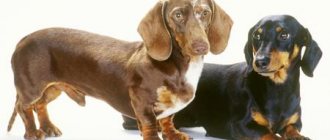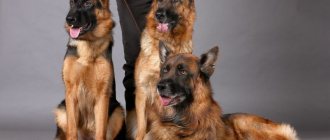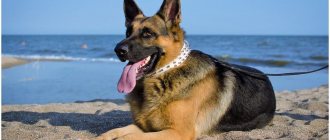The working qualities and high intelligence of German Shepherds are just a few of the reasons for the continued popularity of this breed.
Negative reviews about these dogs are rare, but some dog breeders, when deciding to purchase a puppy, are not aware of the labor-intensive process of caring for him.
Especially when it comes to a bitch in heat, pregnancy and childbirth.
The essence of the process in the body
Estrus is one of the most important stages in a dog’s life, marking the beginning of puberty..
Changes in the dog's behavior during this period are due to changes occurring in its body. At this time, the maturation of eggs occurs in the dog’s genitals and the body is completely ready for fertilization and bearing offspring.
Features of puberty in German Shepherds
German Shepherds are large breeds, which is why they mature a little more slowly.
- Males become sexually mature at the age of 12 months, but at this time their sperm is still poorly suited for fertilization. Puppies from a one-year-old father may be weak and sick. A male who is 2 years old is best suited for mating. At the same time, at the age of 7-8 years, he loses the ability to fertilize.
- A female can be considered fully formed and ready for childbearing at the age of 2-2.5 years. However, puberty occurs earlier.
Early pregnancy can lead to serious consequences for the mother's body, as well as the death of the puppies. This is why a dog is not bred during its very first heat.
At what age does the first heat start?
The first estrus occurs simultaneously with the replacement of milk teeth with molars - at the age of 6 months to 10 months .
At this time, the dog is formally ready to give birth to offspring, but pregnancy will place too much stress on fragile bones and muscles, so mating should be postponed.
Expert opinion
Kozhevin Semyon Kirillovich
Expert dog handler.
In order to maintain good health of the dog and get a litter of puppies without developmental deviations, you should not breed a bitch under 1.5-2 years old. In addition, you cannot neglect vaccination and deworming of the dog and generally breed an unhealthy dog - all the diseases the bitch has will be passed on to the puppies, and as a result, the entire litter will have some pathologies or even die immediately after birth.
What day should you breed a bitch?
The first mating for a German Shepherd can be difficult; the owner must prepare and accurately calculate the time of the onset of estrus. From this time the mating day will be counted.
From the beginning of estrus, there are days on which the dog is most likely to become pregnant - the days of ovulation, which occur on days 10 - 14. For the first time, you can donate blood for hormones at the clinic, where you will be accurately determined for ovulation.
A girl can behave demonstratively, “expose herself” and behave a little strangely. If you press the area of the cross, as when teaching a dog the “sit” command, it will obediently stand in the appropriate position and raise its tail.
You should check in advance whether the dog is ready for mating. To do this, the bitch is pressed with her hands on the sacrum area. If she freezes indicatively and moves her tail to the side, she can be covered. If this is the first mating of a German Shepherd, and there are doubts about the phase of the cycle, you can resort to laboratory diagnostics. A vaginal smear or blood test to measure progesterone levels will help you know exactly when to bring your dogs together.
When mating is carried out correctly, the male covers the bitch the first time. Some breeders prefer to do 2 matings with an interval of 72 hours to guarantee fertilization if they are in doubt on what day ovulation occurred.
Main features
In order not to miss the moment of the onset of estrus and to prepare for the moment of the first discharge, it is necessary to pay attention to factors indicating the approach of the period of sexual activity.
As a rule, before the onset of estrus there is:
- extraordinary molting;
- loop swelling;
- frequent and most often unconscious urination, the purpose of which is to attract the attention of male dogs;
- showing special interest from male dogs;
- changes in character and behavior, refusal to follow commands and disobedience;
- increased activity and energy.
All these signs are not expressed too clearly and are most often noticeable only to experienced breeders.
Beginning dog breeders, in order to make sure of the assumptions regarding the imminent estrus, should daily blot the pet’s loop with a napkin - if the discharge is pink, it means that the estrus has occurred.
Bitch: character
There is an opinion that German Shepherd females have a more submissive and gentle character. But experts believe that character largely depends on heredity and individual characteristics. There are always exceptions, bitches with a very difficult character, and there are males with an easy-going and submissive character. But still, there is a difference in the behavior of the sexes. There are advantages and disadvantages for female and male genders.
Advantages:
- Strong relationship with owner and home
- Emotionally sensitive perception
- Girls are smarter and smarter than boys
- Accepts training tasks well
- During walks, he runs less in the bushes
- Doesn't rush at strangers
- The breed is ideal for breeding, just one assessment from the exhibition is enough
Flaws:
- Sly
- Periodic menstruation
Duration and frequency
How long the estrus will last depends on the individual characteristics of the dog’s body.
On average, the duration of this period is 20-22 days, while an increase in the period to 1 month in German shepherds is not a deviation.
Estrus is a cyclical process in a dog’s body, repeating every 6-7 months, in some cases the interval can be 5-10 months.
In young dogs, some disruptions in frequency are possible, since a regular cycle is established only after the end of the 3rd heat.
A German Shepherd needs to be seen by a veterinarian if less than 5 or more than 10 months have passed between two heats..
Prenatal period
First month
The prenatal period covers the entire two months of pregnancy, right up to birth. Typically, Yorkshire Terrier bitches are pregnant for sixty to sixty-two days.
During the first month of pregnancy, no significant changes are observed in the dog's appearance. Changes in behavior are more noticeable - the bitch becomes lethargic and sleeps often. There may be a lack of appetite due to toxicosis. Although it happens that these signs are absent, because every Yorkie has a unique body and the reaction to changes in it is different for each animal.
The feeding diet can be left unchanged for now. Walks should be daily so that the dog can breathe fresh air and receive solar energy. Exceptions are made only on rainy, too hot or cold days, in order to avoid possible colds or overheating.
The Yorkshire Terrier bitch can still run, but given her delicate position, physical activity should not be long and in no case heavy.
Somewhere on the twenty-second day of pregnancy, future puppies can be felt in the womb of a Yorkshire terrier bitch. But you can’t do this yourself, as you can damage the fruits. If you want to know how many puppies there will be, you can contact an experienced veterinarian.
Echography determines the number of fetuses on the twenty-fifth day of pregnancy, radiography - on the forty-fifth day, ultrasound - from the fiftieth day, when the movements of the future puppies are already noticeable.
Yorkshire Terrier females can give birth to up to four puppies, rarely five, but the volume of the abdomen depends on the individual characteristics of the body. A dog can have a large belly and two fetuses, or a compact tummy with all five fetuses. Therefore, this sign of pregnancy is not always noticeable in the first month. But lightened skin around slightly enlarged nipples is a symptom that is almost always present.
Second month
From the second half of pregnancy it is necessary to change the established regime.
Firstly, change your diet. When feeding ready-made food, you need to switch to special food for pregnant bitches.
If the dog ate natural food, it is necessary to add vitamin and mineral supplements to the food. The veterinarian will help you calculate how much vital substances you need to give your pregnant bitch.
The volume of food should be increased by ten percent every week, focusing on proteins: lean meat, fish. About two weeks before the expected birth, the volume of proteins is reduced, and a week later they are removed altogether. Despite the fact that in the second half of pregnancy the dog needs to be fed more often, it should not be overfed. The main thing is to monitor her weight to avoid obesity.
Secondly, daily walks must be continued, but in quiet places where there are no strangers or other dogs. The Yorkshire terrier bitch should not be allowed to jump or run a lot - the hikes should be short, without overexertion.
Signs of imminent labor include very swollen and clearly defined nipples. Somewhere five to six days before birth, milk should appear. Over the course of three to four days, the bitch's belly begins to sag, as evidenced by her sagging back. The external genitalia of the bitch increase in volume, this is especially noticeable in the last two days before giving birth.
https://youtube.com/watch?v=N14ZuHFvpvo
A couple of days before giving birth, the dog’s behavior changes. She begins to get nervous, run after her owner in search of support, digs her place, and may whine. Some, on the contrary, go to a quiet and dark corner and sit there. Some individuals begin to eat a lot, while others completely lose their appetite.
Two to three days before the expected birth, you need to start measuring the temperature of the pregnant bitch - it should drop to thirty-seven degrees compared to the norm of thirty-eight and a half degrees. They do this early in the morning, while the dog is not yet active, and in the evening before bed. The day before labor begins, the temperature should be as low as possible, and fetal movement should become unnoticeable.
How is it going?
The German Shepherd comes into heat in four stages.:
- Proestrus . This period lasts a maximum of 10 days and is characterized by swelling of the loop, caused by blood flow to the genitals, and bloody discharge. At this time, changes in the dog’s behavior are observed - increased playfulness, attention to individuals of the opposite sex, and sometimes disobedience.
- Estrus . The duration of this phase is 1-2 days. The amount of discharge is significantly reduced, and it becomes pale pink. The dog is ready for mating and does not resist it - it raises its tail and pelvis. To avoid unplanned mating and unwanted pregnancy, the bitch should only be walked on a leash during this period.
- Metestrus . The duration of this stage is 2-3 days. The physiological changes occurring in the bitch’s body are subsiding, and the dog is becoming calmer. Regardless of whether fertilization has occurred or not, progesterone, the pregnancy hormone, is produced at this time. That is why a false pregnancy can occur, the manifestations of which go away on their own.
- Anestrus . This is the time period between estrus, lasting on average 100-150 days. During this period, the bitch is in a state of sexual rest, pregnancy is impossible.
All periods of the reproductive cycle have distinctive features and characteristics that every German Shepherd owner needs to know about in order to avoid the appearance of unwanted offspring or, conversely, achieve a positive mating result.
What should the owner of a bitch do during estrus?
The duration of estrus in a German Shepherd is about 3 weeks, but they can seem like an eternity to the owner. The level of training, upbringing and obedience of your beloved dog does not matter: when the heat begins, the German Shepherd goes crazy. The pet howls, whines, breaks from the leash, creatively sneaks out of the house, and flocks of “fans” are on duty at the entrance. Compliance with certain conditions helps to survive estrus without consequences.
Special panties
Heavy bleeding can be a big problem, especially if the dog climbs onto the sofa or bed. Wearing dog pants with a sanitary pad solves this problem. You can make them yourself, but industrial underpants fit better.
Walking mode
During sexual hunting, the dog is not allowed off the leash for even a minute, and for some individuals a muzzle will be needed in case of aggressive behavior towards other bitches. Avoid other dogs if possible. The pet should be walked by a person who is able to hold it by force if necessary.
Depending on how many times a day your shepherd is walked, a change in routine may be necessary during estrus. They walk more often than usual due to frequent urination.
Planning
The estrus period is an unfavorable time for transportation, exhibitions, and competitions. Such events will have to be cancelled. Vaccination is not advisable. Sterilization surgery is also not performed during estrus.
Use of medications
When there is a high concentration of stray dogs or visiting common walking areas, special sprays are used to attract less males:
- "Touchable" (Le Artis);
- “Flirting? No!" (BioVax);
- “True Friend” (Vergas Soft);
- Anticobelin (Himola);
- "No Love" (Beaphar);
- "Dog Stop Spray" (Canina).
The choice of such drugs is very wide. None of them are 100% effective, but according to reviews from owners, such a spray can be useful. It is often necessary to use natural sedatives for the bitch herself if she loses her appetite, constantly howls and is very nervous:
- Da-ba Relax Plus (Gi-Gi);
- Fitex (AVZ);
- Cat Bayun (Veda).
But the use of hormonal drugs in shepherds is best avoided, since they have significant side effects.
Observation by a veterinarian
The owner should know how long his dog's normal heat lasts. Any deviations from usual behavior during this period, or changes in the nature of discharge, are a cause for concern. If your shepherd doesn't go into heat, it could be a sign of uterine inflammation, an ovarian cyst, or another reproductive organ disorder. Then you need to contact a veterinary center, where it is possible to do an ultrasound and undergo tests.
Features of care
Estrus, despite the naturalness of this process, is stress for the body of a German shepherd . Therefore, for the normal well-being of your pet, it is important to provide her with certain care and closely monitor her health and behavior.
First of all, it is necessary to exclude the possibility of unwanted pregnancy.
To do this, during the period of heat, the bitch should be locked in a house or enclosure, not giving her the opportunity to run away or the males to get to her, and the pet should only be walked on a leash.
IMPORTANT!
A month before the start of estrus, it is important to carry out routine vaccination, and 5-7 days before the first discharge appears, deworming.
This is done to produce healthy offspring and eliminates the possibility of intrauterine infection of puppies.
The bitch should not swim in open water and freeze - during estrus, all the animal’s organs are open, which significantly increases the risk of contracting infections.
Healthy puppies without hereditary developmental disorders can only be born to a well-groomed and healthy dog that eats a balanced diet and has completed a course of vaccinations .
Caring for a dog during heat
During the period of estrus, the body of the German Shepherd is very vulnerable. To maintain her health, it is necessary to provide her with special care:
- The dog should not freeze or swim in dirty water.
- The female often licks herself, so there is no need to wash her.
- It is necessary to provide a complete diet, which will include meat, vegetables, fruits, and grains. Vitamin supplements can be used.
- Physical activity is reduced.
The German Shepherd should be protected from stress. If she wants to lie on her mat, don't bother her.
Dog walking rules
Having smelled the scent of a female in heat, the surrounding males will not remain indifferent. To avoid unwanted pregnancy, some owners lock their pet at home for several days. But this is the wrong approach, because the dog needs walks not only to relieve himself.
During the estrus period, it is enough to walk the German Shepherd on a leash away from other dogs.
It is important! Females during estrus tend to run away, so they need to be closely monitored outside.
Use of medications
Many owners, in order not to attract surrounding males, use special preparations. They help suppress the symptoms of estrus and reduce the amount of pheromones that the dog releases. Such drugs most often affect the level of hormones in the animal’s body. This is quite dangerous and not always effective.
There are also special sprays that suppress the smell of the female. In addition, you can use traditional methods. For example, a strong infusion of bay leaf is quite effective. They need to treat the loop and the area around it.
The effect of this product will not last long, but for walks or urgent trips it is quite enough.
Special panties
To protect furniture and carpets from discharge, you can wear underpants on your German Shepherd. You can buy special diapers at the pet store, but they are not cheap.
You can also buy regular dog panties at a pet store and add a feminine sanitary pad to them. Ordinary human diapers are also suitable, in which you can make a hole for the tail.
As a last resort, you can sew the panties yourself. To do this, you just need a small piece of fabric and an elastic band.
How do you know when a dog is ready for breeding?
Mating too early (in estrus 1 or 2) can lead to difficult childbirth and a difficult postpartum period. There is also a high probability of infertility, sagging backs and the appearance of puppies with congenital pathologies and developmental anomalies.
Due to the loss of flexibility of the hip joints, which increases the risk of a cesarean section, mating of adult dogs over 4 years of age can also be dangerous..
The most suitable age for breeding a German Shepherd is 1.5-2 years. At this age, the dog has stable hormonal levels, joints and muscles are formed and have the necessary flexibility.
In order for mating to give a positive result, it is necessary to correctly determine the most suitable day.
There are several methods for this:
- medical - the most reliable way to determine the optimal mating day, based on a laboratory test of a smear from the bitch’s vagina;
- visual - the dog shows its readiness for mating with its entire appearance: it sits down, raises its tail, its loop is enlarged, swollen nipples are visible, the discharge is scanty, light pink;
- mathematical - ovulation occurs 11-14 days after the onset of proestrus, 1-2 days before this is the most suitable time for mating.
Recording the dates of each heat in a separate notebook or notepad will help you most accurately determine the day of ovulation.
Laboratory diagnostics
During the period of estrus, the female’s entire body and her genitals prepare for coitus. The changes that occur can be recorded using laboratory tests.
Vaginal cytology
Examination of the vaginal epithelium is of diagnostic importance. During estrus, its thickness increases several times, and the surface cells become keratinized. This provides protection against infections and physical injury.
During proestrus, leukocytes, red blood cells and keratinized epithelial cells that have lost their nucleus will be visible in smears. At the time of estrus, red and white blood cells become single, and the keratinized epithelium predominates over all other cells.
For comparison, during the period between heats, a vaginal smear will contain cells from the middle layers of the epithelium: intermediate and parabasal. This is the so-called atrophic smear during a period of decreasing estrogen concentration in the body.
Determining the level of progesterone in the blood
When progesterone in the blood begins to prevail over estrogen, the dog ovulates. Blood donations for hormones begin 5 days after the start of estrus, every 2 days. Such analyzes help to find out the timing favorable for mating. Ovulation occurs when progesterone levels reach 5-10 ng/ml.
How to choose a pair
The choice of a male for mating is one of the most important moments when breeding this breed, on which the quality of the litter depends.
It is necessary to study all the advantages and disadvantages of the applicant in order to exclude the possibility of mating with a male dog who has the same set of negative qualities as the female, and to become familiar with his pedigree.
In addition, since puppies most often inherit their external characteristics from their father, the male must be better in appearance than the female.
You should also, if possible, examine puppies previously born from this male - this will allow you to determine which qualities are inherited from him.
In search of a suitable male, you can contact the club where the female is a member or look for a partner via the Internet.
It is important to understand that the cost of mating depends on the quality, titles and compliance with the male breed standard .
Childbirth in a dog
A number of signs indicate that a dog is about to give birth: enlarged mammary glands, loss of appetite, mucous discharge, a decrease in rectal temperature by 1 degree, restless behavior, rapid breathing... A few hours before the onset of contractions, the animal takes a characteristic position - lies down, stretches its front legs forward and lowers his head. The beginning of labor is considered to be the breaking of amniotic fluid. You can read about all the nuances of this process and all its stages in the publication, which describes in detail the birth process in dogs.
Childbirth in a dog can last from several hours to a day and a half. The birth of puppies is considered the active phase of labor. The bitch immediately licks the babies, freeing them from the membranes of the amniotic sac, gnaws the umbilical cord and eats the afterbirth, which appears after the puppy. After some time, the next puppy is born
Please note that the number of afterbirths must correspond to the number of puppies born. And, if the afterbirth does not come out, this is a reason to seek help from a veterinarian, since an inflammatory process may begin in the bitch’s body
How does a dog behave during childbirth?
In such an extreme situation as childbirth, the instincts inherent in Nature are activated in the animal’s body. Therefore, if the birth proceeds without complications, the dog’s condition is satisfactory, and the puppies do not have breech pathologies - the dog can give birth on its own, then it behaves calmly and there is no need to provide it with help. True, if the dog is acting restless and rushing about, you can sit next to the animal, talk to it, and gently pat it on the head
This kind of attention from you will calm the dog down and it will stop panicking and will be able to focus on what is happening now in its body.
As a rule, dogs lick their newborn puppies - this is one of the basic maternal instincts, however, if you suddenly notice that this is not happening, observe the further behavior of the bitch. This may mean that she did not recognize her puppy, and the maternal instinct in her body did not awaken in relation to him. It is likely that in the future she may refuse to feed such a puppy, and therefore, you will have to look for a replacement nursing mother or feed him with special mixtures yourself.
How to help your dog during labor
If you do not have special veterinary knowledge, then, unfortunately, providing complex and qualified veterinary care is out of the question. It is better to trust a professional in this case. A,
If for some reason the veterinarian was unable to arrive or is delayed, and labor has already begun, you must be prepared to provide all possible assistance to the dog.
So, for example, if you see that the dog does not free the puppy from the amniotic membranes within 2 minutes after he is born, they will need to be torn apart, as the baby may suffocate. However, you should not completely remove them - you need to make a hole above the muzzle so that the puppy can breathe. The mother will still have to remove the remaining shells. Likewise, if the dog cannot bite through the umbilical cord, it is too strong; it can be carefully cut with sterile scissors and then severed. After this, you can bandage the umbilical cord and lubricate the incision site with iodine.
You also need to ensure that the dog's bedding is as clean as possible at all times and change it if necessary.
When to contact a veterinarian
If contractions last more than 45 minutes, but the active phase of labor does not occur, the period between births of puppies is more than 2 hours, during or after childbirth the dog begins to bleed profusely or have purulent discharge, the bitch has weak and unproductive contractions, narrow birth canal or the puppies are large, walk forward with their hind legs and tail, or are even stuck in the birth canal - it is recommended to contact a veterinarian or take the animal to a veterinary clinic. Each of these situations can threaten the health and life of the dog and its offspring. Therefore, in this case there is no need to hesitate - every minute counts.
Why and how should you prepare your pet?
Only an absolutely healthy dog can be allowed to breed.
Therefore, in addition to routine vaccination, treatment against helminths and external parasites, you should also collect cultures and submit a bacteriological analysis, the results of which can reveal the presence of viral herpes, streptococcus, staphylococcus or other hidden infections in the dog.
CAREFULLY!
These diseases can cause a deterioration in the shepherd's condition and lead to the death of the litter.
The time before and after mating is a period when the bitch especially needs a good, balanced diet; mating with a dog that is underweight or, conversely, overweight, should not be allowed .
Why is there no heat?
With good general health and the state of the reproductive and hormonal systems, the dog's first heat occurs at the established usual times and then repeats with a certain cyclical regularity. If the dog is older than 18 months, and the first heat has not come, you should consult a veterinarian to find out the reason for this delay.
The main reasons for the delay/absence of the first heat:
- poor living conditions, improper or insufficient feeding;
- disruption of hormonal regulation of the reproductive system;
- congenital disorders in the development and structure of the genital organs;
- ovarian dysfunction (hypofunction, lack of appropriate hormones during the appropriate period);
- dysfunction of the pituitary gland and/or thyroid gland;
- tumors and/or other neoplasms, cysts of the pelvic organs or directly on the ovaries;
- endocrine pathologies;
- chronic inflammatory processes in the uterus;
- hermaphroditism (for example, when underdeveloped testes are found instead of ovaries).
Basic Rules
Mating of dogs should take place on the territory of the male dog - this way he feels more confident, calmer and is not distracted by unfamiliar surroundings and smells.
The following rules must be followed:
- Mating should be done in the morning, before the first meal;
- both dogs need to be walked, giving them the opportunity to empty their bladders and bowels;
- during the mating process there should be no extraneous, distracting sounds;
- if the female requires lubrication, you need to use cream or Vaseline;
- To prevent dogs' paws from slipping, the floor should be covered with carpet;
- It is necessary to hold the dogs by the collars.
After several cages, the so-called lock occurs, connecting the dogs to each other, and ejaculation.
Finding partners for mating
Mating in German Shepherds is a prerequisite for breeding. Many breeders, before giving away a puppy, say in advance whether the shepherd dog will be used for breeding.
You need to untie a male dog by the age of 2 years, and then take part in breeding regularly.
The first mating for a girl German Shepherd and the first time for a male are equally important. If matings are carried out incorrectly, boys may stop expressing themselves, so it is not recommended to allow young dogs to act independently; it is better to control the process.
They select a pair based on their exterior characteristics; a smart choice will eliminate the shortcomings and preserve the existing advantages.
It is important to pay attention not only to external data, but also to job characteristics, as well as mental state
Each dog must meet the following criteria:
- Age at least 1.5 years;
- Availability of all vaccinations;
- Screening for genetic diseases;
- Stable psyche, without aggressiveness or fearfulness.
A good option would be if the animals know each other. If they are unfamiliar, give them time to get used to it and get comfortable. The main thing is not to interfere, be prepared to observe and help if necessary.
The pet will feel comfortable only in the presence of the owner. Be calm and do not raise your voice; you can praise him or her approvingly once the process has already begun.
If the dog doesn’t fall into the loop the first time, it’s okay. He needs to be given time to rest, or helped on his own. Hold the bitch, move her tail and even guide her with your hand. The main thing is that the animal does not have time to get tired and become overexcited.
Even if the bitch snaps, there is no need to panic. You need to calm her down, hold her by the collar or even fix her head, and wait for the lock.
How does pregnancy go and how long does it last?
The average gestation period for German Shepherds is 60 days . At the same time, the minimum duration of gestation is 58 days, the maximum is 65.
Changes in the bitch’s body begin already in the 1st month after mating, although there are no external signs of this yet.
Immediately after mating, it is necessary to exclude all stressful situations for the dog and provide her with the most comfortable living conditions, otherwise a miscarriage may occur.
Clear and noticeable signs of pregnancy can be seen starting from 2 months:
- there is an enlargement of the nipples and mammary glands;
- the belly grows;
- The dog's body weight is actively increasing.
Upon reaching 50-55 days, you can notice a drooping of the abdomen, the appearance of slight discharge from the loop, and when you press on the nipple, drops of colostrum appear from it.
At 6-7 weeks of pregnancy, an experienced veterinarian can feel the puppies in the womb.
Dog examination
Upon completion of the preliminary procedures, it is necessary to proceed to examining the puppy. In order to get a purebred, faithful friend, you should remember the main characteristics of this species.
The danger of buying small puppies is that the breed characteristics are not visible.
Coat and color
Babies, as a rule, have black fur. Their coat is often covered with a slight "gray" that will disappear after the first molt. At the same time, purebred shepherd dogs cannot have any white spots.
Note! As Germans grow older, they develop a “mask” on their faces, as well as other signs of thoroughbred. In non-purebred dogs, spotting remains for life.
Shepherds have a rather stiff coat without folds or saggy, flabby areas. Mutts have silkier fur.
Main features: head
If the dog's head is disproportioned relative to the body, then most likely it is not a purebred German. In purebred dogs, the forehead is of medium width, convex in shape and does not hang over the muzzle.
The black nose lobe does not have any points. Slight hump nose is allowed. The inside of the lips may be spotty - this is not bad, but undesirable. The bump on the back of the skull should be easily palpable.
Back, chest
The back of the Germans is quite strong and not very long. There are no fractures in the lumbar region. The sternum is wide; in young individuals it should not sag below the level of the elbow joint.
Examination of parents and their puppies
If the breeder has nothing to hide, then he will allow you to visit the puppy’s parents without any problems. It is necessary to observe the father and mother, for example, during a walk, compare external and behavioral characteristics with the standard.
Examination of the puppy's parents
Topline of a German Shepherd
The topline is the visual line that runs from the base of the neck to the base of the tail. In purebred dogs, it has smooth outlines, without any clearly segmented areas.
Tail
Shepherds have a fairly long tail. The tail part ideally continues the spinal column. When excited, it should not rise above the level of the main line, and when the tail is tucked, no pit should form.
Thick-footed puppies have middle paws that are parallel and pressed to the sternum at the elbow. The heels, like the claws, are painted dark. The fingers close into a ball.
Important! You should not buy dogs with vestigial or removed toes. When choosing a representative of the German breed, you should compare the weight parameters of the animal with the table
When choosing a representative of the German breed, you should compare the weight parameters of the animal with the table.
German Shepherd puppy weight
Young shepherd dogs' ears stand up only at six months of age. Often they first look like a “house”, then they fall, and only later they begin to rise one by one until they are completely strengthened.
The optimal number of teeth is 28. The bite should have a scissor-like appearance. The incisors on both jaws should be opposite each other. In shepherd dogs, the lower canines slightly overlap the upper ones.
Frame
If the height of the dog’s body at the withers is commensurate with the length of the body (quadratic shape), and its height exceeds 60 cm, then most likely a mestizo is being sold under the guise of a purebred shepherd dog. The main sign of noble blood is a smooth topline.
How does childbirth go?
The approaching birth can be judged by changes in the behavior of the German Shepherd - she begins to whine, scratch the bedding, and tries to hide in a dark place, hiding from prying eyes.
The dog refuses to eat, lies down all the time, her breathing quickens, and when you look at her, you can see the muscles trembling and the puppies moving.
The birth process is divided into 3 stages:
- before childbirth - a process of frequent muscle contractions in the uterus, leading to dilatation of the cervix, which is invisible externally and can last up to 30 hours;
- birth of puppies - after the cervix is fully dilated, the dog experiences contractions and straining - contraction of the abdominal muscles, facilitating the movement of the puppy through the birth canal;
- after the birth of a puppy, the placenta is released, containing useful substances that promote the continuation of labor and lactation, so it is useful for the dog to eat it, but not more than 2 pieces, otherwise there is a possibility of diarrhea.
When a puppy is born, the bitch bites the umbilical cord and licks it, stimulating life processes.
You cannot rush and stimulate the dog at the birth of the first puppy - this can only harm both it and the offspring..
On average, childbirth without complications can last about 12 hours, the interval between the appearance of babies is 1 hour.
If 2 hours or more have passed since the birth of the last puppy, we can judge that labor has stopped.
Pregnancy
Visually, signs of pregnancy become noticeable in the animal 1-1.5 months after fertilization. The female’s body takes on a rounded shape, and the belly hangs down. The nipples can be felt well. They swell and harden with the flow of milk.
However, similar signs appear during a false pregnancy. To finally make sure of the interesting situation of your pet, it is better to contact a veterinarian. He will perform a thorough examination and help determine the time of birth.
Terms and signs
German Shepherds do not have a clear regulation for the duration of pregnancy. Each dog bears offspring in individual terms, on average 60-65 days.
Long-term practice of observing purebred animals has made it possible to establish a number of patterns:
A pregnant female noticeably changes her behavior. She becomes calmer and spends more time next to her owners. During the gestation period, the animal eats and drinks a lot. At the same time, inexperienced bitches who become pregnant for the first time often continue to lead an active lifestyle. Owners need to carefully monitor the behavior of the expectant mother so that she does not harm herself and her offspring.
Stages of an interesting situation
Normal pregnancy in a German Shepherd lasts 60-65 days. During this time, intrauterine development of the fetus occurs. It consists of several stages:
Responsible preparation for the upcoming birth requires knowing exactly the duration of pregnancy in a German Shepherd. There are 2 ways to calculate:
Medical diagnostics allow you to determine the date. With a multiple pregnancy, whelping occurs earlier than with a small pregnancy.
The day before contractions begin, the animal's hair around the anus, genitals and belly is shaved. Normally, puppies appear within 3 hours to 1 day (video from the channel “MY LIFE and MY DOGS”).
Preparation
When bearing offspring, the diet undergoes changes towards increasing the proportion of foods containing vitamins (A, B, D, E) and calcium. It is advisable to feed the female meat (beef, lamb), cottage cheese, eggs. In addition, she needs a large amount of liquid every day, so the drinking bowl must be constantly filled with clean water.
The floor below is covered with disinfected oilcloth and bedding. The woman in labor should be comfortable and warm. Very often labor pains in purebred animals are sluggish, so it is better to invite a veterinarian in advance. It will help the pet give birth to offspring at the crucial moment.
Symptoms
The first signs of impending whelping appear 5 days before it begins. The female behaves restlessly, runs around the house, whines. Bitches that have given birth ooze milk from their nipples. In firstborns, the mammary glands swell and begin to work immediately before contractions.
It is extremely important to monitor the appearance of mucous discharge from the genitals. Their color indicates the health status of the animal:. On the eve of the onset of contractions, the shepherd’s behavior and appearance change noticeably:
On the eve of the onset of contractions, the shepherd’s behavior and appearance change noticeably:
Main process
In purebred animals, labor lasts from 3 to 15 hours. First, contractions appear, and then the dog begins to push. The breaking of water signals the arrival of the baby. Usually the firstborn is the largest puppy.
The mother independently releases the baby from the amniotic sac and gnaws the umbilical cord. Carefully licks the newborn. Sometimes dogs eat their offspring while licking, so owners need to control the situation.
The offspring are temporarily separated from the mother and placed in a warm, dry box. The bitch is allowed to see the children after completing a postpartum walk outside and undergoing sanitary and hygienic procedures.
The interval between the birth of doggies ranges from several minutes to an hour. At this time, the shepherd dog eats the remaining placenta. She needs to replenish the balance of proteins in the body. However, more than 4 afterbirths are not allowed. Exceeding the amount leads to intoxication.
Frequent mistakes of owners during mating and childbirth
A number of mistakes that owners of German Shepherds often make during breeding and childbirth of a dog:
- Attempts to “swing” a slow and restless male with the help of screams, pats and pushes. So, on the contrary, it will not give the dog the opportunity to calm down, but will only increase his nervousness.
- Careless assistance to the male during mounting: for example, touching his genitals. This will cause the male to stop acting. The mating will end in failure. When the male is covering the female, you should not disturb him.
- Owner's excitement. Dogs feel all the feelings of the owner. Therefore, a person’s excitement will easily be transmitted to a German.
- Poor preparation for childbirth. In certain situations, this will harm the puppies and the giving birth female.
- Taking newborn puppies from their mother.


